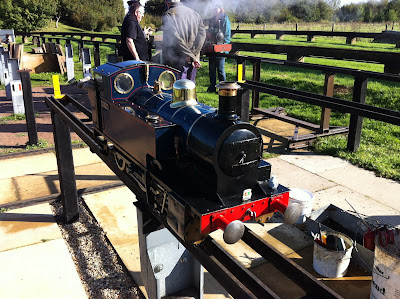 |
| LH Assembly - Con Rod, Crosshead, Drop Arm and Gudgeon Pin |
In order to allow the rebuild of "Achilles" to progress at a faster rate, Eddie had offered to contract the work for the two new crossheads. Kindly, he has been ticking away at them at a good pace, putting my mind at rest about not having them done in time for the season. The crossheads arrived as a single piece of metal, with the early markings of what looked like crosshead shapes on the sides. This of course has to be sawn in half and filed heavily in order to achieve surfaces that can be accurately machined to create the final crossheads.
 |
| Turning The Boss On The R/H Side New Crosshead |
As well as the various bushes and the two new crossheads, there are other jobs still to be done on the loco itself. The whistle turret for example requires a new washer before being put back together, whilst the water gauge glass bottom-nut section requires packing and sealing before the gauge glass goes back in. My hope is to get the engine back together by the end of March in order to perform a test steaming at home, prior to actually undertaking any track work. Realistically I would say that the valve gear will need resetting once the engine is back together but, just at present, the aim is to get it back together to a condition where it can actually move itself pretty soon!...
A job which I had sort of 'missed out' during my calculations was the relationship between the gudgeon pin and the little end. Having decided to test that relationship today I found that there was a strong amount of wear in the little end bushes on both sides and so opted to make some new whilst I had the time and Eddie's workshop handy! Having found the internal diameter of the little end section of the rods, and an accurate size for the gudgeon pins, I started turning the new pair. The process of turning is something that I've learnt through work and is quite enjoyable on little jobs like this, and pretty easy. Below, the bronze is being turned down to the external diameter...Next, the bronze rod was drilled out to a diameter just slightly smaller than the gudgeon pins; to allow for possible drill run-out etc. The hole is then reemed in order to provide the best surface finish, clear the burrs and of course produce the accurate shape. Below, I get stuck in with the drilling...
Once you've got your internal and external diameters right, you can check the appropriate depth before 'parting off' the job. Below, I'm preparing to part-off the bronze to create two new bushes...
Occasionally, particularly with a soft material like this, the parting off cut may cause some swarf to remain on the finished jobs. This is easily removed by putting the part carefully back into the chuck and then running the knife tool gently across until the face is clean and shiney. And there you have it!...
 |
| One of The Bushes Having The Final Clean Up |
 |
| Gudgeon Pin Fitted |
Lets hope that by April the old girl will be sitting back on the bays at Ryton pools...in steam, squeaky clean, shiney and of course...tight! The below image was taken in October at RPMR, as "Achilles" simmers with 80psi on the clock, before a few laps of the track...
Thanks for reading again guys - Best Regards, Sam.









1 comment:
Hi Sam, I enjoyed reading about the Achilles re-build, very interesting, and we get to see Eddie's workshop as well! One question, do you have to drill new oil holes in the new bushes? If so, did you do this before, or after they were pressed in?
Great blog BTW!
Kind regards,
Emma-claire.
Post a Comment